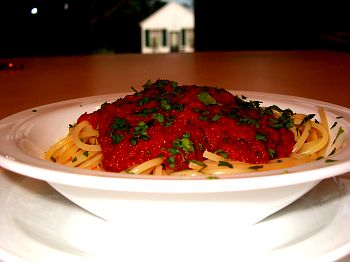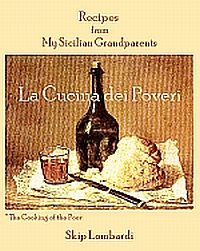Pasta al Sugo Finto
October 16th, 2007
I‘ve been jonesing for Sugo Finto, literally, fake sauce, since I read the most recent menu of Mario Batali’s flagship restaurant, Babbo. Apparently Mario’s latest Tasting Menu features transcendent Duck Tortelli with Sugo Finto.
Duck is an iffy proposition at the mega-stores here on the Sun Coast of Florida, but the ingredients for Sugo Finto are available everywhere. Besides, Sugo Finto also tastes pretty good on pasta gnudi, plain pasta.
The common translation for Sugo Finto is ‘meatless ragù,’ probably derived from the fact that it’s a tomato sauce cooked for nearly as long as a traditional meat sauce. Sugo Finto begins with a batutto of garlic, carrot, celery, onion, and parsley. But unlike traditional batutto, this mixture is cooked to the point at which it caramelizes. The pot then gets deglazed with red wine and tomatoes. Herbs go in, and the sauce simmers gently for approximately an hour. The result is rich, intense, and could easily hold its own in the presence of a duck. But as I said, it’s pretty good on plain pasta, too.
Pasta al Sugo Finto
Pasta with ‘meatless’ meat sauce
Ingredients:
For the Batutto
2 – 4 Cloves garlic, peeled
1 Medium carrot, peeled and roughly chopped
1 Medium stalk celery, roughly chopped
1 Medium onion, peeled and quartered
1/2 Cup flat-leaf Italian parsley, leaves and stems
For the Sauce
Extra-virgin olive oil
1 Cup dry red wine
2 28 Oz. cans Italian plum tomatoes, preferably San Marzano
Approximately 1 cup loosely packed chopped herbs: parsley, basil, rosemary, sage, thyme, nepitella, etc.
Salt & freshly ground black pepper
1 Lb. Spaghetti
4 Tbs. Flat-leaf Italian parsley, finely chopped
Freshly grated Parmigiano
Preparation:
Place the garlic, carrot, celery, onion, and parsley in the bowl of a food processor. Pulse approximately ten times at one second per pulse. Scrape down the sides of the bowl if necessary, and pulse once or twice more.
Heat a 4 quart pot over medium-high heat, then add enough olive oil to lightly the bottom. Add the batutto and stir to distribute evenly in the pot. Lower the heat to medium, and cook, stirring occasionally, until the mixture begins to caramelize.
Raise the heat to high, and add the wine. Cook for three or four minutes over high heat to evaporate the alcohol and to reduce the wine by approximately twenty percent.
Lower the heat to medium-low, then add the tomatoes, breaking them up with the back of a fork as they go in. Add half the herbs, season with salt and pepper, and allow the sauce to simmer gently for approximately an hour. Stir in the remaining herbs, and remove from the heat.
In the meantime, as the sauce nears completion, bring a large pot of water—at least six quarts—to the boil. Add the spaghetti, and cook just to the al dente state. Remove from the stove and drain in a colander.
To Serve:
Serve family style by pouring the pasta on a platter, ladle sauce over the top, and garnish with the parsley. To serve individually, divide the pasta equally among four plates, ladle a dollop of sauce on top, and garnish with the parsley.
Pass the Parmigiano separately at the table.



